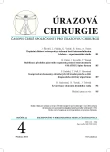-
Medical journals
- Career
SUPPLEMENTATION OF OSTEOSYNTHESIS OF FEMUR BY AN INTERMEDULLARY NAIL – EXPERIMENTAL STUDY
Authors: Jan Škvařil 1; Ladislav Plánka 1; Karel Veselý 2; Robert Srnec 3; Alois Nečas 4
Authors‘ workplace: Department of Pediatric Surgery, Orthopaedics and Traumatology, the Faculty Hospital, Brno 1; Klinika dětské chirurgie, ortopedie a traumatologie, Fakultní nemocnice Brno 1; Institute of Pathological Anatomy, the Faculty of Medicine and the Faculty Hospital of St. Anna, Brno 2; Patologicko-anatomický ústav LF MU a FN u sv. Anny v Brně 2; Small Animal Clinic, Department of Surgery and Orthopaedics, University of Veterinary and Pharmaceutical Sciences of Brno the Faculty of Veterinary Medicine 3; Klinika chorob psů a koček, Oddělení chirurgie a ortopedie, Veterinární a Farmaceutická 3; University of Brno, the Faculty of Veterinary Medicine 4; Univerzita Brno, Fakulta Veterinárního lékařství 4
Published in: Úraz chir. 22., 2014, č.4
Overview
Aim:
The subject of experimental studies of the treatment of bone defects is not only the osteosynthesis of bones itself, but also the search for an appropriate „filling“. The presented study is the continuance of the main part of the scientific research project, which was implemented in cooperation with the workplaces of Department of Paediatric Surgery, Orthopaedics and Traumatology, the Faculty Hospital Brno and University of Veterinary and Pharmaceutical Sciences of Brno, in the years 2012-2014. This scientific research project focused on the search for an appropriate biological and synthetic filling for a bone defect. The aim of the presented study is to evaluate whether more quality and quicker healing of the bone defect treated by means of standard bone graft method occurs, in case the fixation by an angle-stable plate is supplemented by intramedullary nailing using an elastic nail. The experimental model was a miniature pig.Material and methods:
The experimental groups were made up of 13 miniature pigs. In 7 pigs the fragments of femur were fixed only by an angle-stable plate, in 6 pigs the fragments were fixed by an angle-stable plate supplemented by means of application of intramedullary Kirschner wire with the diameter of 3.0 mm. In both groups the bone defect, which occurred, was filled with autogenous bone graft. After healing, this area was processed from the histological point of view and evaluated with respect to the formation of new bone tissue and engraftment to the original bone in the area of the edges of the defect.Results:
The results demonstrate that the tissue in the place where the bone defect occurred is more often evalua-ted as a mature bone after being fixed by an angle-stable plate, together with intramedullary fixation. The comparison was not significant from the point of view of statistics.Conclusion:
The study demonstrated that the supplementation of osteosynthesis using an angle-stable plate in the femur where a large defect occurred (after being filled by means of autospongioplastics) by an intramedu-llary nail shows a more advanced and quality healing in the new bone than in case of osteosynthesis by means of splint itself. The results were not significant from the point of view of statistics, but they demonstrate a greater mechanical strength of combined osteosynthesis while preserving the miniinvasivity of intramedullary nail fixation.Key words:
Bone defect, osteosynthesis, autogenous bone graft.
Sources
1. LEVENT. C., YALCIN, Y., ERKAL, B. et al. Treatment of distal tibia shaft fractures: results of intramedullary nails with uniplanar distal locking, intramedullary nails with multiplanar distal locking and medial locking plates. J Bone Joint Surg. 2011, 93-B, SUPP II 213.
2. KONNING, T., MAARSCHALKERWEERD, RJ., ENDENBURG, N., et al. A comparison between fixation methods of femoral diaphyseal fractures in cats - a retrospective study. Journal of small animal praktice. 2013, 54, 248–252.
3. SHOEMAKER, SD. COMSTOCK, CHP., MUBARAK, SJ. et al. Intramedullary Kirschner Wire Fixation of Open or Unstable Forearm Fractures in Children. J Ped Orthopaedics. 1999, 19, 329–337.
4. ŠKVAŘIL, J., PLÁNKA, L., SRNEC, R. et al. Experimentální léčba diafyzárního kostního defektu využitím trikalciumfosfatu. Úraz chir. 2013, 21, 10–16.
5. VAN, DR, WILLIAM, L., OTSUKA, NY. et al. Intramedullary Nailing Versus Plate Fixation for Unstable Forearm Fractures in Children. J Ped Orthopaedics. 1998, 18, 9–13.
6. VON PFEIL, DJ, DÉJARDIN, LM, DECAMP, CE, et al. In vitro biomechanical comparison of a plate-rod combination-construct and an interlocking nail - construct for experimentally induced gap fractures in canine tibiae, Am J Vet Res. 2005, 66, 1536–1543.
7. WELCK, M., CALDER, P., EASTWOOD, D. Supplementary locked plating in addition to intramedullary fassier duval rod stabilisation in osteogenesis imperfekta. J Bone Joint Surg. 2013, 95-B, SUPP 231.
Labels
Surgery Traumatology Trauma surgery
Article was published inTrauma Surgery

2014 Issue 4-
All articles in this issue
- SUPPLEMENTATION OF OSTEOSYNTHESIS OF FEMUR BY AN INTERMEDULLARY NAIL – EXPERIMENTAL STUDY
- Stabilisation of the anterior pelvic ring segment by ©MATRIX Spine System
- Compressive fractures of thoracic spine vertebras in children: diagnosis and treatment algorithm
- External fixation of distal radius fractures
- Trauma Surgery
- Journal archive
- Current issue
- Online only
- About the journal
Most read in this issue- Compressive fractures of thoracic spine vertebras in children: diagnosis and treatment algorithm
- External fixation of distal radius fractures
- SUPPLEMENTATION OF OSTEOSYNTHESIS OF FEMUR BY AN INTERMEDULLARY NAIL – EXPERIMENTAL STUDY
- Stabilisation of the anterior pelvic ring segment by ©MATRIX Spine System
Login#ADS_BOTTOM_SCRIPTS#Forgotten passwordEnter the email address that you registered with. We will send you instructions on how to set a new password.
- Career

